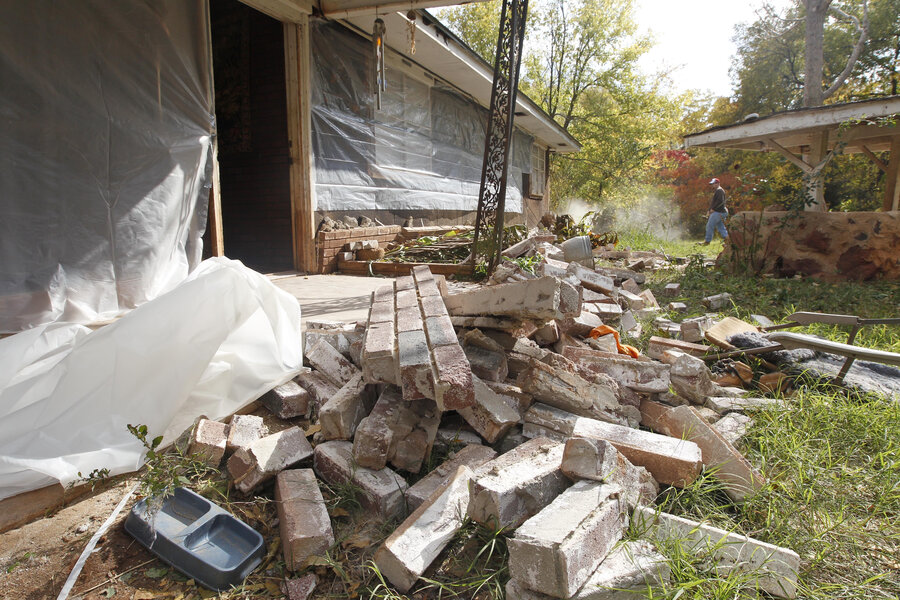Are man-made earthquakes on the rise? USGS report says yes
Loading...
Human-induced earthquakes are a serious problem, suggests the US Geological Survey (USGS) in a study released Monday.
Seven million residents between the Midwestern states of Oklahoma, Kansas, Texas, Colorado, New Mexico, and Arkansas live or work in areas threatened by man-made earthquakes linked to fracking’s wastewater disposal wells.
The USGS decided to include human-induced earthquakes in their seismic risk maps after Oklahoma, which now competes with California for the title of most quake-prone state, had an especially active year. In 2015, Oklahoma experienced 907 earthquakes of a magnitude of 3.0 or higher, compared with just two of this size in 2009.
And while USGS’ new heavily dotted map is alarming, there seems to be a level of agreement between fracking’s supporters and opponents. Environmentalists and energy companies agree that the earthquakes are caused by the disposal of post-fracking wastewater. And both sides also agree that the earthquakes need to stop.
"The thing about Oklahoma is that we are an oil and gas state," Chad Warmington, president of the Oklahoma Oil and Gas Association, tells The Christian Science Monitor in a phone interview Tuesday. "The large producers that are here have a large presence here and a lot of employees. It is not some out-of-state company that isn’t affected by [the earthquakes]. We want to reduce them as well."
But the process of fracking – and its connection to earthquakes – is complicated.
The fracking process begins by drilling vertically for thousands of feet beneath the Earth’s surface before pivoting and drilling horizontally for anywhere between 6,000 feet and two miles. Hydraulic fracturing fluid – a combination of water, sand, and chemical additives – is then pumped through the L-shaped well at very high pressure to create fractures in the surrounding rock formation. Oil and natural gas then move from the fractures into the L-well, replacing the fracturing fluid and reversing directions back up the well.
But it is not just oil and natural gas that reach the surface. A fluid referred to as "flowback" or "produced water" also escapes from the underground rocks along with the oil and gas. After engineers separate the produced water from the oil and gas, the unwanted water is re-injected deep into the Earth. And it is this post-fracking injection of a water-like byproduct that causes earthquakes.
Mr. Warmington says it is important to understand this process because it proves the majority of earthquakes are not directly caused by fracking, but by a secondary process.
But Seth Gladstone, deputy communications director for Food and Water Watch, a founding member organization of Americans Against Fracking, says it’s one and the same.
"It is all a part of the larger fracking process. You can’t frack and not deal with the waste products – there are no safe ways to handle this waste," Mr. Gladstone tells The Monitor. "It is highly toxic and radioactive and because the industry can’t find any better solution they put it back in the ground, causing earthquakes."
"The way to stop earthquakes is to stop the injection of this wastewater," adds Gladstone. "And the way to stop [the injection of wastewater] is to stop fracking."
But Warmington says the fracking industry just needs to find the local limit for this wastewater.
"[Injection] is the safest, most environmentally conscious way to dispose of the wastewater, and there is a level of injection that doesn’t cause earthquakes," says Warmington. "We just have to learn the combination of how much water and where that won’t cause earthquakes. We need to figure out this balance."
The 12 counties that have witnessed the most earthquakes are also drilling sites with the largest proportions of fracking-induced wastewater. Within the past three months, the Oklahoma Corporation Commission has agreed to reduce wastewater injection by 40 percent of 2014 levels. To do so, oil and gas companies can simply avoid the wastewater-heavy formations and focus on the rest of the 77 fracking counties.
"Reducing injection will have a corresponding decrease in production, and that’s just going to have to be OK," says Warmington.
Anti-frackers say the earthquake solution doesn’t call for running to the drilling sites that will conjure up less wastewater.
"We deal with highly toxic substances by putting them in the ground?" asks Gladstone. "This is an absurdity in principle."






